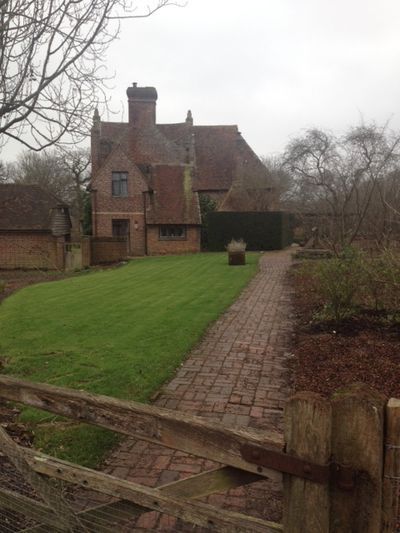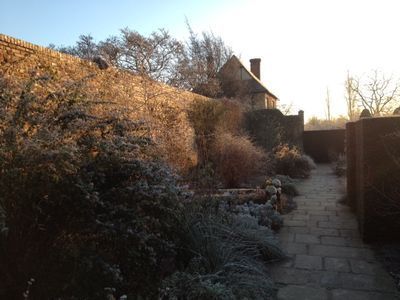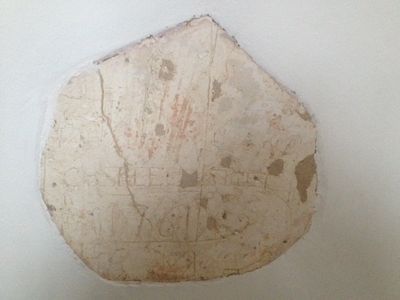New Year at Sissinghurst
By TOBY LICHTIG
Don't tell everyone but it turns out you can stay at Sissinghurst. I don't mean the small and picturesque village in Kent, near the splendid estate where Vita Sackville-West and her husband Harold Nicolson resurrected the ruins of a Renaissance manor and lived for three decades until their deaths in the 1960s. I don't even mean the B&B on the fringes of the estate. I'm talking about a small Elizabethan cottage, the Priest's House, slap bang in the middle of the estate itself and fringed by the renowned “white garden” designed by Vita.
Sissinghurst Castle Garden has for many years been administered by the National Trust, which, in its wisdom, lets out the Priest's House to weekenders willing to pay National Trust prices to stay in a cosy, three-bedroomed cottage, complete with mullion and leaded windows, brick floors and inglenook – a word I've always admired but never previously had the chance to employ. 200,000 people visit Sissinghurst Castle Garden every year, but not many of them in December and January. Even in the middle of the day it felt like we had the run of the estate.
Upstairs at the Priest's House, you can stay in the quaintly sloping bedroom where Vita drew her last breath (she was moved from the larger house during her final illness). Downstairs is a small but well-stocked library for guests' use, containing, among the usual English country cottage jumble of novels by Jilly Cooper, Stephen Fry and Zadie Smith, several books about Sissinghurst and its gardens, biographies of Vita and Harold, and books by Vita and her descendants, including her late sons Benedict Nicolson (the art historian) and Nigel Nicolson (the author, publisher and MP) and Nigel's son Adam Nicolson, who until recently still lived on the estate.
Perusing Nigel Nicolson's memoir about his unconventional parents, Portrait of a Marriage (1973), I came across a passage written by Vita, following the beginning of her affair with Violet Trefusis, whose seductive portrait (by Sir John Lavery) still stands in the wonderful writing room in Sissinghurst’s Elizabethan tower. In 2013, a poem by Vita about Trefusis came to light, after falling out from between the pages of a book during restoration work in the writing room. In it (as rendered in the translation from the original French by the scholar Harvey James), Vita reflected on the "intoxicating night" during which
"I search on your lip for a madder caress
I tear secrets from your yielding flesh
Giving thanks to the fate which made you my mistress."
In the passage from Portrait of a Marriage, however, Vita is rather more philosophical. She writes, of her "connection" with Violet:
"I hold the conviction that, as the centuries go on, and the sexes become more nearly merged on account of their increasing resemblances . . . such connections will to a very large extent cease to be regarded as merely unnatural, and will be understood far better, at least in their intellectual if not in their physical aspect. (Such is already the case in Russia.) I believe then that the psychology of people like myself will be a matter of interest, and I believe it will be recognized that many more people of my type do exist than under the present-day system of hypocrisy is commonly admitted. I am not saying that such personalities, and the connections that result from them, will not be deplored as they are now; but I do believe that their greatest prevalence, and the spirit of candour which one hopes will spread with the progress of the world, will lead to their recognition, if only as an inevitable evil."
It was richly satisfying (as well as poignant) to read this passage at the end of the year in which same-sex marriage legislation finally passed into force in England and Wales (the same cannot be said of Vita's aside about Russia, given current attitudes to homosexuality there). And if Vita might have baulked at the sight of six slightly dishevelled Londoners lounging around with wine and books in her final home, one can only imagine that she'd be delighted with the "spirit of candour" and "spread of progress" prevalent in at least this aspect of modernity.
Sissinghurst itself has evolved in surprising ways over the centuries. A former Saxon pig farm, the estate became the site of a moated manor house, visited by Edward I in the early fourteenth century and 250 years later by Elizabeth I, whose 200-strong retinue nearly bankrupted the owners, the Baker family. In the eighteenth century, it briefly became a notoriously ghastly prisoner-of-war camp for 3,000 French sailors, taken captive during the Seven Years' War. Graffiti by the prisoners can still be seen scratched into the walls of the tower.
War came to Sissinghurst in a milder form during Vita and Harold's tenure, when the herds of cattle on the estate were managed by members of the Women's Land Army.
Today, Sissinghurst is both a great place for a daytrip and, it transpires, a bijou holiday destination. It was a delightful place to bring in the new year. But best not spread the word or everyone will know . . . .
Peter Stothard's Blog
- Peter Stothard's profile
- 30 followers






